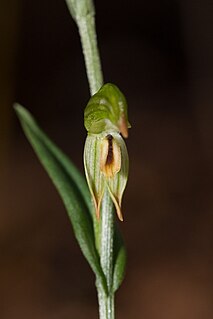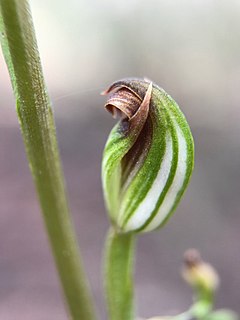
Pterostylis ventricosa is a recently described and critically endangered species of orchid endemic to a small area of New South Wales. As with similar orchids, the flowering plants differ from those which are not flowering. The non-flowering plants have a rosette of leaves but the flowering plants lack a rosette at the base but have up to six tiny green, white and brown flowers.

Pterostylis jonesii, commonly known as the montane leafy greenhood, is a plant in the orchid family Orchidaceae and is endemic to a small area of south-eastern Australia. Individual plants have either a rosette of three to six leaves or a flowering spike with up to eleven flowers and five to seven stem leaves. The flowers are translucent green with faint darker green lines and have a brownish-yellow labellum with a dark stripe.

Pterostylis multiflora, commonly known as the tall tiny greenhood, is a species of orchid endemic to south-eastern Australia. As with similar orchids, plants in flower differ from those that are not. Those not in flower have a rosette of leaves lying flat on the ground. Plants in flower lack a rosette but have up to twenty tiny green, white, and brown flowers in summer. The flowering stem has up to six stem leaves.

Pterostylis rubescens, commonly known as the blushing tiny greenhood, is a species of orchid endemic to south-eastern Australia. As with similar orchids, the flowering plants differ from those which are not flowering. The non-flowering plants have a rosette of leaves but the flowering plants lack a rosette at the base and have up to eighteen tiny green, white and brownish flowers.
Pterostylis agrestis is a plant in the orchid family Orchidaceae and is endemic to Victoria. It has a rosette of leaves and when flowering, up to fourteen transparent green flowers with a blunt, greenish-black appendage on the labellum. It is similar to the black-tip greenhood, Pterostylis bicolor but that species has larger, less crowded flowers and is found in different habitats.

Pterostylis amabilis is a species of orchid endemic to eastern Australia. As with similar orchids, the flowering plants differ from those which are not flowering. The non-flowering plants have a rosette of leaves but the flowering plants lack a rosette at the base but have up to ten tiny white and red to reddish-brown flowers. It is similar to P. parviflora but has larger rosette leaves and larger, more brightly coloured flowers.
Pterostylis anaclasta is a plant in the orchid family Orchidaceae and is endemic to Queensland. It was first formally described in 2010 by David Jones who gave it the name Oligochaetochilus anaclastus. The description was published in The Orchadian from a specimen grown at the Australian National Botanic Gardens from a cutting collected near Eungella Dam. In the same year, Jasmine Janes and Marco Duretto changed the name to Pterostylis anaclasta.
Pterostylis arfakensis is a plant in the orchid family Orchidaceae and is endemic to Indonesian West Papua in New Guinea. It was first formally described in 1917 by Johannes Jacobus Smith who gave it the name Pterostylis papuana var. arfakensis. The description was published in Lilian Gibbs's book A Contribution to the Phytogeography and Flora of the Arfalk Mountains from a specimen collected in the Arfak Mountains. In 2002 David Jones and Mark Clements raised it to species level as Pterostylis arfakensis.
Pterostylis clivicola is a plant in the orchid family Orchidaceae and is endemic to a small area near the border between New South Wales and Victoria. It has a rosette of leaves and up to fourteen green flowers which have a labellum with a dark green, beak-like appendage.
Pterostylis crassa, commonly known as the coarse leafy greenhood, is a plant in the orchid family Orchidaceae and is endemic to Victoria. As with similar greenhoods, plants in flower differ from those that are not. Those not in flower have a rosette of leaves on a short stalk but when flowering, plants have up to four relatively large, shiny dark green translucent flowers on a flowering stem with stem leaves.
Pterostylis exalla is a plant in the orchid family Orchidaceae and is endemic to South Australia. It was first formally described in 2009 by David Jones and given the name Oligochaetochilus exallus. The description was published in the journal The Victorian Naturalist from a specimen collected on the Wombat Plains in the Southern Lofty region. In 2010, Gary Backhouse changed the name to Pterostylis exalla. The specific epithet (exalla) is derived from the Ancient Greek word exallos meaning "quite different".
Pterostylis frenchii, commonly known as the tuart rufous greenhood, or tuart rustyhood is a plant in the orchid family Orchidaceae and is endemic to the south-west of Western Australia. Both flowering and non-flowering plants have a relatively large rosette of leaves. Flowering plants also have up to twelve white and green or white and brown flowers which lean forward and have a small, fleshy, insect-like labellum.
Pterostylis extranea is a plant in the orchid family Orchidaceae and is endemic to Queensland. It was first formally described in 2010 by David Jones and given the name Oligochaetochilus extraneus. The description was published in the journal The Orchadian from a specimen grown in the Australian National Botanic Gardens from a tuber collected near Eungella Dam. In 2010, Jasmine Janes and Marco Duretto changed the name to Pterostylis extranea. The specific epithet (extranea) is a Latin word meaning "strange".
Pterostylis ferruginea, commonly known as the Bangham rustyhood, is a plant in the orchid family Orchidaceae and is endemic to the border area between South Australia and Victoria. It has a rosette of leaves and when flowering, up to ten upright, dark green and translucent white flowers which have an insect-like labellum.
Pterostylis incognita, commonly known as the Sale greenhood, is a plant in the orchid family Orchidaceae and is endemic to Victoria. It has a rosette of leaves and when flowering, up to twelve crowded flowers on a stem with a rosette at the base. The type specimen was collected near Sale in 1895 but was not formally described or given a name until 2009, by which time it was presumed extinct.
Pterostylis pearsonii is a plant in the orchid family Orchidaceae and is endemic to Queensland. It was first formally described in 2010 by David Jones and given the name Oligochaetochilus pearsonii. The description was published in the journal The Orchadian from a specimen grown in the Australian National Botanic Gardens from a tuber collected near Eungella Dam. In 2010, Jasmine Janes and Marco Duretto changed the name to Pterostylis pearsonii.

Pterostylis vernalis, commonly known as the spring tiny greenhood, is a species of orchid endemic to New South Wales. As with similar orchids, the flowering plants differ from those that are not currently flowering. Non-flowering plants have a rosette of leaves at the base. Flowering plants lack that rosette, but have one or two rosettes on lateral growths. The flowers are green, brown and white. This greenhood is only known from a small area near Nowra.
Pterostylis mystacina is a plant in the orchid family Orchidaceae and is endemic to Queensland. It was first formally described in 2010 by David Jones and given the name Oligochaetochilus mystacinus. The description was published in the journal The Orchadian from a specimen found on Mount Moffat near the Carnarvon National Park. In the same year, Jasmine Janes and Marco Duretto changed the name to Pterostylis mystacina. The specific epithet (mystacina) is derived from the Ancient Greek word mystax meaning "hair on the upper lip".
Pterostylis hadra is a plant in the orchid family Orchidaceae and is endemic to the south-west of Western Australia. It was first formally described in 2015 by David Jones and Christopher French and given the name Oligochaetochilus hadrus. The description was published in the journal Australian Orchid Review from a specimen collected near Cranbrook. In the same year, Jones changed the name to Pterostylis hadra "to allow for the different taxonomic views held at generic level within the subtribe". The specific epithet (hadra) is derived from the Ancient Greek word hadros meaning "stout", "strong" or "great", referring to the robust habit of this species.
Pterostylis rubiginosa is a species of orchid endemic to northeastern New South Wales. Flowering and non-flowering plants have a rosette of leaves that is withered by the time flowering occurs. Flowering plants have up to seven white flowers with rusty brown stripes, on a wiry flowering stem.





